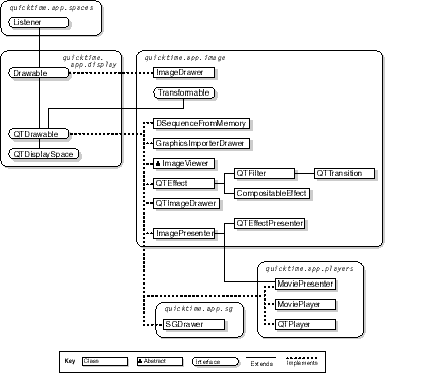Working With the QTDrawable Interface
As we've seen, the
QTDrawable
interface is used to handle the negotiation between the
QTCanvas
and one of several QuickTime objects. The QuickTime objects that implement the
QTDrawable
interface are extensive and include the following:
-
the
QTPlayer
class, which presents the movie controller
-
the
MoviePlayer
or
MoviePresenter
classes, which present the
Movie
data type
-
the
GraphicsImporterDrawer
class, which wraps the graphics importer to present images from a data source, typically image files
-
the
ImagePresenter
class, which presents the
DSequence
but for a single image only, allowing image data to be loaded and kept in memory, providing a faster redraw than the
GraphicsImporter
object
-
the
SWCompositor
class, which presents the sprite world
-
the
SGDrawer
class, which presents the sequence grabber and sequence grabber channel (video) components
-
the
GroupDrawable
class, which groups
QTDrawable
objects into the same canvas.
-
the
QTEffect
class, which wraps the visual effects architecture of QuickTime
-
the
QTImageDrawer
class, which allows the results of Java painting into a
java.awt.Image
to be captured and drawn by QuickTime
The
QTDrawable
interface is designed to work hand-in-hand with a
QTCanvas
object. The class that implements this interface draws into the supplied
QDGraphics
object
.
The
QTCanvas
will call the methods of its client (setting its destination
QDGraphics
, setting display bounds, and redrawing it) as required.
Figure 3
The QTDrawable implementation
© 1999 Apple Computer, Inc.| Previous | Chapter Top | Next |

